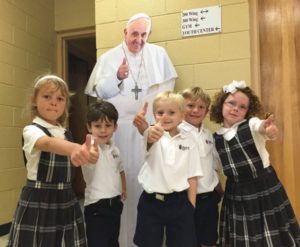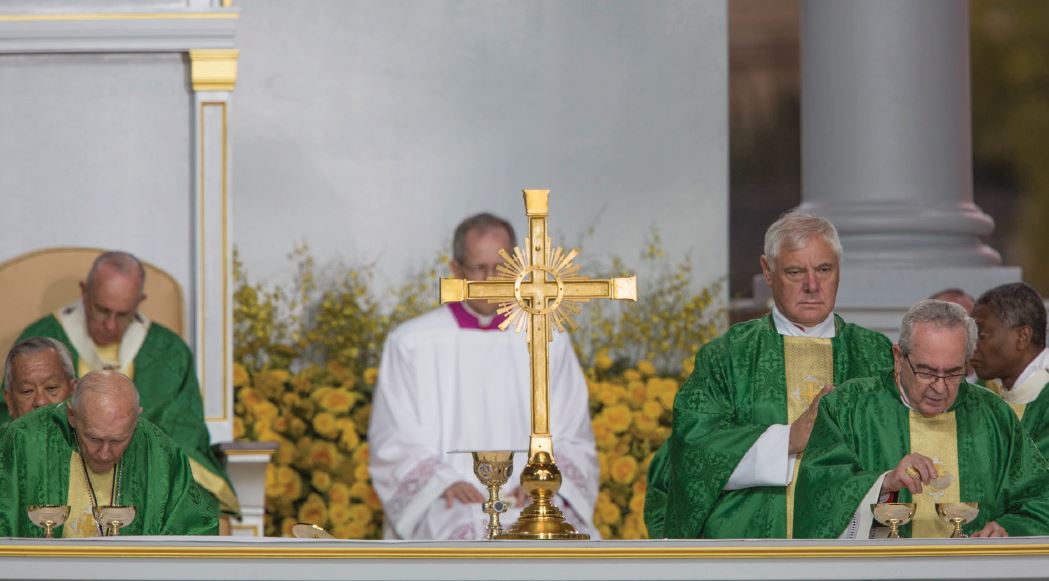Diocese of Knoxville sees pope’s U.S. impact firsthand
By Jim Wogan
The images will last for decades.
But Catholics around the world and within the Diocese of Knoxville are praying the real impact of Pope Francis’ six-day visit to the United States goes beyond that.
Starting with his arrival from Cuba on Sept. 22, Pope Francis immediately captivated a nation consumed with divisiveness, caustic political debate, and concerns about its future — and he challenged everyone to look inward, and to God, for positive solutions.
He did it with a style that has come to defi ne his short time as pope.
“I think everybody is going to have concerns if we didn’t hear what we wanted to hear. Through the gift of the Holy Spirit, Pope Francis is telling us what we need to hear,” said Bishop Richard F. Stika, who attended a midday prayer service with Pope Francis at the Cathedral of St. Matthew the Apostle in Washington D.C., on Sept. 23.
 “The thing I hope people realize, after his visit, is that we are all loved by Jesus and that our faith is important and that our faith is uplifting,” Bishop Stika said. “The pope has told all Christians, don’t be sourpusses. Faith isn’t something we’re supposed to dread and put up with. It is supposed to be joyful. Yes, there are crosses to bear, but faith is supposed to be a joyful thing.”
“The thing I hope people realize, after his visit, is that we are all loved by Jesus and that our faith is important and that our faith is uplifting,” Bishop Stika said. “The pope has told all Christians, don’t be sourpusses. Faith isn’t something we’re supposed to dread and put up with. It is supposed to be joyful. Yes, there are crosses to bear, but faith is supposed to be a joyful thing.”
Joy was a key component of the Holy Father’s visit. It was visible everywhere.
His initial welcome at Joint Base Andrews outside Washington included smiles and handshakes from President Barack Obama, Vice President Joe Biden and U.S. Catholic dignitaries— among them, Archbishop Joseph E. Kurtz of Louisville, the president of the U.S. Conference of Catholic Bishops and the former bishop of the Diocese of Knoxville.
After a brief private gathering, the Holy Father departed Andrews air base riding inside a small Fiat car — a symbolic gesture that was immediately embraced by the secular and religious media covering his visit. The image was not lost on Bishop Stika and his colleagues.
“We all kind of smiled when we saw all these secret service vehicles and SUVs and all of a sudden you see this little Fiat surrounded by these massive vehicles,” he said. “The pope insisted in keeping the window down too, and he was kind of hanging out the window and waving at people—which they appreciated.”
While the contrast of styles was stark—the leader of 1.2 billion Catholics riding through the streets of powerful
Washington, D.C., in a compact car, the pope was poised and equally prepared to play ball on a very big stage.
 It was hard to dodge the political ramifications of the Holy Father’s first few days in the United States. It started with a welcome ceremony attended by 13,000 spectators on the south lawn of the White House on Sept. 23.
It was hard to dodge the political ramifications of the Holy Father’s first few days in the United States. It started with a welcome ceremony attended by 13,000 spectators on the south lawn of the White House on Sept. 23.
Among those in attendance was Cardinal Justin Rigali of Knoxville, who has served three popes and was in the conclave that elected Francis pope in 2013.
After the White House event, Pope Francis traveled to St. Matthew Cathedral, where he met for the first time with U.S. bishops.
“The general conversation among the bishops was that it is good for the pope to see the Church in the United States as something that has energy and that has vitality and how we all work together,” Bishop Stika said.
“In his talk to the United Nations he asked people to pray for him; not just Catholics, but people who have faith. And for non-believers, he said please wish me good luck. He is asking for everyone to support him in one way or another. He really is a spokesman for all of the silent world, not just one nation or one continent or for the wealthy or the poor, but for everybody.”
Francis concluded his first full day in the United States with a Mass to canonize Junipero Serra, a Franciscan priest who established Catholic missions in California in the 1700s.
Bishop Stika was a concelebrant at the Mass.
“The bishops were right in front of the altar area. We got there early and there were thousands of people there already. It was history. It was the first time a saint was canonized on American soil,” Bishop Stika said.
“I have been at canonizations in Rome, most recently St. John Paul and St. John XXIII. The canonization part, they present the candidate and it all takes place in the first 15 minutes of Mass and there’s a formula and he invokes his authority as pope and he declares the person to be a saint and to be honored by the universal Church.
“For Father Serra’s Mass, I was at the end of an aisle. At the beginning, a relic of the saint is presented. A person walked past me with the reliquary and we touched shoulders. He had a cape of feathers, I am guessing he was a native American and coming back up the aisle he looked almost terrified but he also looked serene like he knew he was a part of history.”
The Holy Father’s second day in the United States included more history. His message delivered to a joint session of Congress—with Supreme Court justices and other dignitaries in attendance—was a first for a pope.
With thousands of people watching on large projection televisions outside on the National Mall, and with Tennessee’s congressional delegation among those inside, the diminutive, soft-spoken successor of St. Peter delivered a powerful 50-minute speech in English.
“All of us are quite aware of, and deeply worried by, the disturbing social and political situation of the world today,” Pope Francis said.
 “Our world is increasingly a place of violent conflict, hatred and brutal atrocities, committed even in the name of God and of religion… Our efforts must aim at restoring hope, righting wrongs, maintaining commitments, and thus promoting the well-being of individuals and of peoples. We must move forward together, as one, in a renewed spirit of fraternity and solidarity, cooperating generously for the common good.”
“Our world is increasingly a place of violent conflict, hatred and brutal atrocities, committed even in the name of God and of religion… Our efforts must aim at restoring hope, righting wrongs, maintaining commitments, and thus promoting the well-being of individuals and of peoples. We must move forward together, as one, in a renewed spirit of fraternity and solidarity, cooperating generously for the common good.”
It was among the many speeches the Holy Father delivered throughout the week. Bishop Stika cautioned those who were inclined to partition each into its own separate message.
“One speech builds upon another, and that speech builds upon the next. His audience isn’t for here and now, it’s for next week, and for next year and for all history,” Bishop Stika said.
“Popes not only speak to the present, they speak to the future.”
The Holy Father’s visit to Washington included lunch with about 300 homeless clients at a shelter operated by Catholic Charities. The next day, the pope traveled to New York City and was met there by Cardinal Timothy Dolan, archbishop of New York and a frequent visitor to the Diocese of Knoxville.
The New York portion of his trip included a ride through Central Park with an estimated 80,000 people there to see him. Following that, the pope celebrated Mass at Madison Square Garden. The next day, the pope delivered a speech to the United Nations
General Assembly, attended a multi-faith service at the 9/11 Memorial and visited schoolchildren in Harlem.
The culmination of his U.S. visit — and the real reason he chose to travel here — was a trip to Philadelphia for the World Meeting of Families. On Sept. 26, Pope Francis celebrated Mass at the Cathedral Basilica of Sts. Peter and Paul. Cardinal Rigali was a concelebrant.
That night, Cardinal Rigali joined Pope Francis and other Catholic leaders at the Festival of Families— an event that combined prayer and worship with performances by singers Aretha Franklin and Andrea Bocelli, among others. Actor Mark Wahlberg emceed.
Nearly 200 parishioners from the Diocese of Knoxville—including students from Notre Dame High School in Chattanooga and Knoxville Catholic High School— made the trip to Philadelphia for the World Meeting of Families events.
They were there the next day when Pope Francis ended his U.S. visit by celebrating an outdoor Mass in front of the Philadelphia Museum of Art.
Various reports estimated attendance for the Mass to be 1 million.
His Philadelphia visit included a trip to meet with inmates at a local prison and a private meeting with victims of past sexual abuse by clergy.
Throughout his entire visit, the 78-year-old pope remained upbeat and insightful. It was his first trip to the United States in any capacity.
Bishop Stika was the chief organizer of the 1999 visit of Pope John Paul II to St. Louis, and he has a special appreciation of the behind-the-scenes logistics during papal visits. He also has met other popes and recognizes that in his brief time as leader of the Catholic Church, Pope Francis is shaping his own identity.
“The one thing I have experienced with the three popes that I have met is that there is serenity about them all. Pope John Paul II, when he was first elected, was like a rock star. He did things that weren’t done before — not because popes didn’t want to, but, for the most part, popes never left Rome. John Paul believed himself to be St. Paul in terms of his missionary zeal. He really impressed people.
He drew millions of people,” Bishop Stika said.
“Pope Benedict was a great teacher. To me he was very pastoral, and he had a big, warm heart. I enjoyed my time with him because he would engage you in conversation. Pope Benedict was very warm. Pope John Paul was very holy and mystical, and Pope Francis is starting to shape his persona.
“They say John Paul was a philosopher for the Church and Benedict was a great teacher. I think Pope
Francis is the heart. They were all pastoral. But this pope’s personality might lend itself more to that.”
The heart of the Catholic Church left the United States on Sept. 27. In his time here, he gave us big smiles, great words, and many things to think about.

